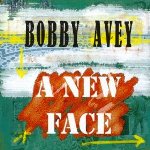Home » Jazz Articles » Live Review » Norwegian Road Trip, Part 5: Molde Jazz, Days 1-2
Norwegian Road Trip, Part 5: Molde Jazz, Days 1-2
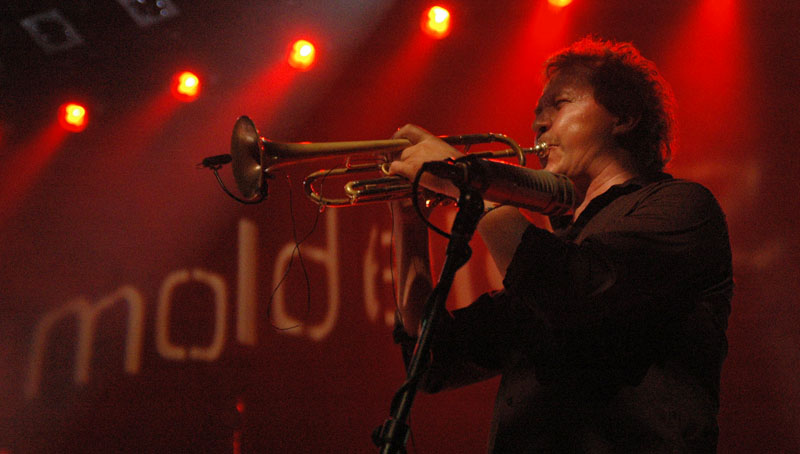
[Editors Note: From July 6 to July 26, 2010, All About Jazz Managing Editor John Kelman will travel throughout Norway to cover both the Kongsberg Jazz Festival (also participating in Silver City Sounds) and Molde Jazz. He'll also spend a week between the two famous festivals in Oslo, where he'll check out the scene, talk to musicians and labels, and visit the legendary Rainbow Studio for a look around and an interview with engineer Jan Erik Kongshaug, who has participated in hundreds of ECM recordings. He'll publish every second or third day, so be sure to follow him as he goes from the east coast to the west, in search of Norwegian artists known and unknown].
While it would be faster to fly from Oslo to Molde, it wouldn't be a proper road trip without taking the train, a stunning seven-hour trip that includes journeying from Dombås—the highest rail point in the country—to Åndlasnes, about an hour outside of Molde. The 90-minute rail trip from Dombås to Åndlasnes features some of the country's most stunning scenery; but also proof of Norway's intrepid nature when it comes to ensuring there's a proper infrastructure capable of delivering all the necessary services throughout the country.
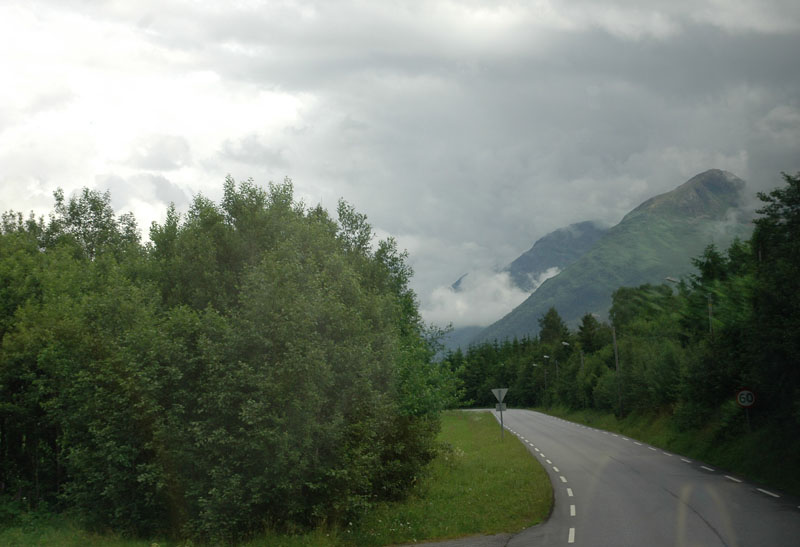
And that's a real challenge, because Norway's small population (now approaching five million) is not concentrated in a handful of larger cities; instead, the train ride from Oslo to Molde demonstrated just how spread out Norway's inhabitants are. Hardly a mile went by where there wasn't evidence of some small community, nestled at the foot of a large mountain or situated along a river or lake. Norway's road system makes its way around mountains, but also through them, with seemingly countless tunnels cutting through some of the largest peaks; but how the train wound its way from Dombås to Åndlasnes was particularly remarkable. In a 1,340 meter tunnel, the train made nearly a 360 degree turn as it descended from Dombås to the bottom of Romsdal Valley, actually coming out traveling in the opposite direction and nearly 19 meters above where it entered the tunnel.

It was a day of sun and clouds, which made for some spectacular scenery. Leaving Oslo, the landscape became increasingly vivid, first with rolling hills and green landscapes, but gradually becoming increasingly rough and craggy, with mountains gradually emerging in the distance and blue-green glacial waters reflecting the sun and clouds. Some of the country's best fishing could be found in the country between Oslo and Molde, as the train crossed the country from east to west; Lake Lesjaskog, an 11 kilometer lake with rivers running from both ends, the watershed between east and west Norway and a rich source of trout and graylings. Farther along, the River Rauma wound its way to a fjord, one of the country's best places for salmon fishing, as they migrate there from the ocean near Greenland, to spawn just below Kylling Bridge.

Kylling Bridge was impressive in and of itself. 76 meters long and 59 meters high at its apex, it was built between 1913 and 1923, and demonstrates Norwegian ingenuity long before oil gave the country the money to implement its more thorough infrastructure. But before coming to the bridge, the 380 meter Vermafossen waterfall was another highlight amongst highlights; a stunning natural wonder that is also used to generate electricity for the region.
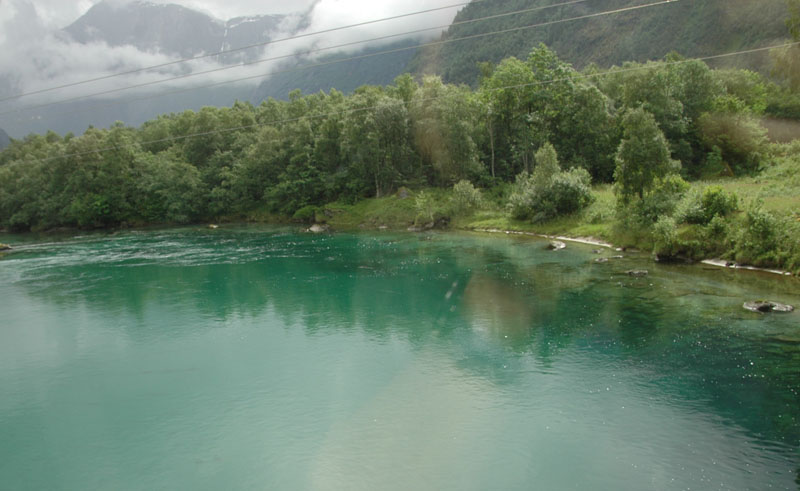
Arriving in Åndlasnes, it was impossible to imagine how anyone could ever become complacent about being surrounded by such stark and stunning beauty. With mountain peaks rising everywhere, Åndlasnes was a small crossroads location where buses to other places met the train's arrival. Still, it was far more than a small town, with lovely architecture and, despite being distanced from larger centers, hardly wanting for any of the social services that are such an inherent part of the Norwegian fabric of daily life.

An hour-long bus to Molde continued the intimate look at some of the country's most stunning mountain scenery. A 10-minute ferry ride across a fjord provided a combination closer look and panoramic view, before finishing up the trip to Molde winding through more rolling landscape along the large fjord on which Molde is situated, 25 kilometers from the Atlantic Ocean. Arriving in Molde, a town of 25,000 surrounded by 222 mountains, it's impossible to imagine a more gorgeous location for a jazz festival. Farther north than Oslo, the days are also a little longer at this time of year, with night approaching at 10:30PM, but still in a strange kind of elongated twilight where shades of blue remained in the sky, peaking through the cloud cover.

It was a perfect way to be welcomed back to Molde, as the town prepared for the jazz festival's 50th anniversary, a stellar year that, in addition to featuring Artist in Residence Nils Petter Molvaer and Label in Residence Rune Grammofon, will host fifty artists/groups including In The Country, Puma, Bushman's Revenge and Terje Rypdal. There will also be a special, one-time performances by Motorpsycho with the Sula Art Ensemble, Trondheim Jazz Orchestra and Trondheimsolistene, a new project from Ketil Bjornstad (being recorded by ECM), and an all-star collaboration by Gary Burton, Tommy Smith, Arild Andersen and Alex Riel. All-in-all, a great year to be in Molde.
Chapter Index
- July 19: Laying the Foundation and Art Exhibits
- July 19: Nils Petter Molvær Opening Performance
- July 19: In the Country
- July 19: Farmers Market
- July 20: Javid Afsari Rad
- July 20: Magic Pocket & Trondheim Jazz Orchestra
- July 20: Burton/Andersen/Smith/Riel
July 19: Laying the Foundation and Art Exhibits
Plenty is written about fearless Norwegians, the benefits of having the money to invest in the arts and a kind of reckless innovation where no idea is a bad one. But an event during the morning of Molde Jazz's first day brought all three together.
 Det Hvite Hus Groundbreaking
Det Hvite Hus GroundbreakingWith a new library being built for Molde—laws to promote literacy in Norway mandate that there must be a certain number of books available per capita—it's indicative of the country's approach to collaborative thinking that the venue will also house a cinema and a new performance space. The number of performances spaces in Molde already far exceed that of similarly sized towns in North America. But at a foundation laying ceremony that, in most places, would feature a couple of speeches by local representatives and nothing more, over a thousand people attended an event that lasted close to an hour, and combined official statements with poetry and music, performance art, and even a bit of live dance/theater.
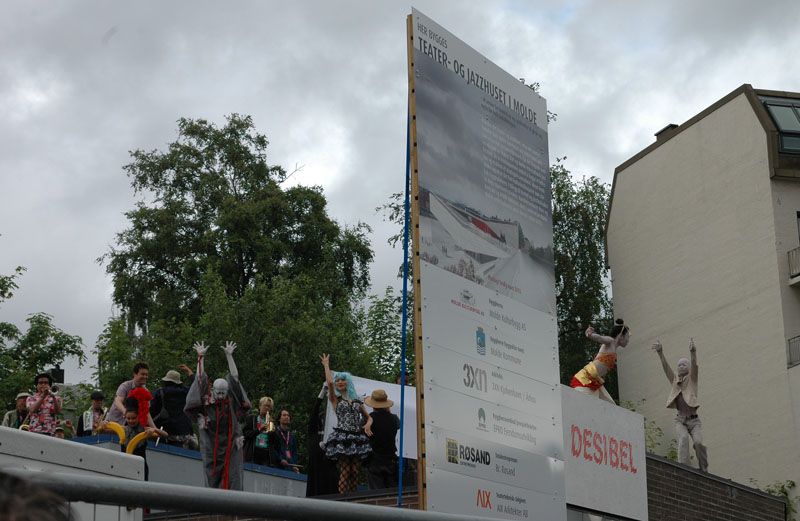 Shibusa Shirazu Orchestra at Det Hvite Hus Groundbreaking
Shibusa Shirazu Orchestra at Det Hvite Hus Groundbreaking Japan's Shibusa Shirazu Orchestra—who would kick off the festival at its large outdoor Romsdalsmuseet (Romsdal Museum) a couple hours later—opened the groundbreaking/foundation laying ceremony with a propulsive, percussion and brass heavy performance that included heavily made-up dancers. A spoken word segment by five festival representatives, including Festival Director Jan Ole Otnæs, was followed by an excerpt from Driving Miles, a festival play written by Henning Mankell that will be running the entire week, and featuring actor Per Egil Aske and trumpeter Jørn Myklebust.
 Tori Wrånes at Det Hvite Hus Groundbreaking
Tori Wrånes at Det Hvite Hus Groundbreaking But, following speeches from federal officials, the real surprise came when an accordion and voice began emanating from the speakers at the site. Looking around, trying to find where the music was coming from, nothing could be seen until Otnæs pointed up to the sky, and it became clear that a crane on the site was not there for the construction of the new building. Instead, hanging off a cable, performance artist Tori Wrånes could be seen gradually being lowered to the ground—though she never actually made it. Instead, she came closer to eye level for the crowd, only to be gradually raised once again to a concrete platform behind the site of the new library.
Only in Norway.
But that wasn't Wrånes' only performance—and she seems compelled to do things that would not only challenge most of her peers; the festival actually had trouble finding a crane operator who would agree to collaborating with her, even though her rider includes a waiver for any and all possible actions in the event that she's injured during a performance. A few hours later, at the local art gallery, another event took place to open the festival's exhibition of artist Kim Hiorthøy's artwork for Rune Grammofon, Molde's first Label in Residence. After speeches including one from Music Information Centre's Martin Revheim, sound again began to emanate.
This time, somehow positioned high up and hanging perpendicular to a tree beside the gallery, Wrånes once again sang (though, with both arms wrapped around the tree, there was no chance for a repeat performance on accordion). When the song was over, and when the opening was over, she remained in the tree as attendees drank, ate and chat.
 Tori Wrånes at Rune Grammofon Art Exhibit Opening
Tori Wrånes at Rune Grammofon Art Exhibit OpeningAgain, only in Norway.
July 19: Nils Petter Molvær Opening Performance
For his opening performance as Artist in Residence at Molde Jazz 2010, Norwegian trumpeter Nils Petter Molvær put together a dream team of international players. From Norway: keyboardist/percussionist Jon Balke, with whom Molvær played in the 1980s with Masqualero, and drummer Rune Arnsen, a member of the trumpeter's original group that began touring around the time of his landmark ECM release, Khmer (1997) and remained in the band until it dissolved a couple years back. From the United States, bassist Bill Laswell, who has been involved in seemingly countless projects, collaborating with saxophonist/Tzadik label head John Zorn in the legendary group Painkiller, as well as co-leading the group Material, whose Hallucination Engine (Axiom, 1993) remains a classic of stylistic cross-pollination. From Africa, two percussionist: Baboucar Camara and Alieu Saine. And, finally, from Ethiopia: singer GIGI, who has made a name for her blending of traditional music with ambient music.
 Nils Petter Molvær
Nils Petter MolværIt seemed like the perfect, large-scale opener for the festival and for Molvær, and there were plenty of strong points about the show. However, it was sadly marred by technical problems—including a booming feedback during the opening atmospherics, the forced the trumpeter to push the band into the Afrobeat pulse faster than he'd planned—and a sense that, perhaps, the group didn't have as much rehearsal time as it could have, with eye contact throughout the show as much about figuring out where to go as how to interact.
That said, if the show was impaired by problems, it remained a complete success for Molvær, who simply could not have played better. While he was situated stage right, with GIGI taking front and center, he remained a commanding and charismatic presence, as he combined electronics, extended techniques and unfailingly lyrical playing into one of his best performances in recent memory. Bolstered by Arnesen's very specific way of creating a dancing pulse, the trumpeter constructed serpentine melodies, using a pitch shifter in an equally distinctive fashion to layer moving harmonies that would otherwise have required three trumpeters to play.
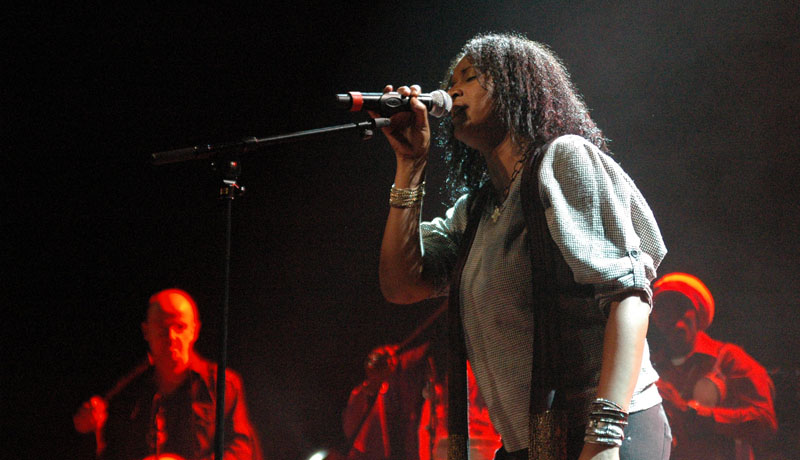 GIGI
GIGIMolvær also took a solo spot mid-set, where he softly sang into the microphone cupped into the bell of his trumpet, gradually building a wash of looped and processed sounds over which he delivered line-after-line of exquisite beauty. It was a virtual tour-de-force of trumpet mastery and the kind of organic technological integration and innovation that has—alongside other Norwegians including guitarist Eivind Aarset, live sampler Jan Bang and saxophonist Hakon Kornstad—set the bar extremely high for others attempting similar feats by making it seem as though all the pedals and rack gear aren't just add-ons to his undeniably fine acoustic trumpet playing; instead they're connected at a mitochondrial level, an extension of his trumpet, just as his horn is an extension of his body.
As thematic as much of Molvær's playing was, he did explore more extreme territory at times, turning his trumpet into a screaming voice that—altered almost unrecognizable by his array of sound processors—demonstrated an unmistakable virtuosity that is rarely on overt display, but absolutely must underscore everything he does.
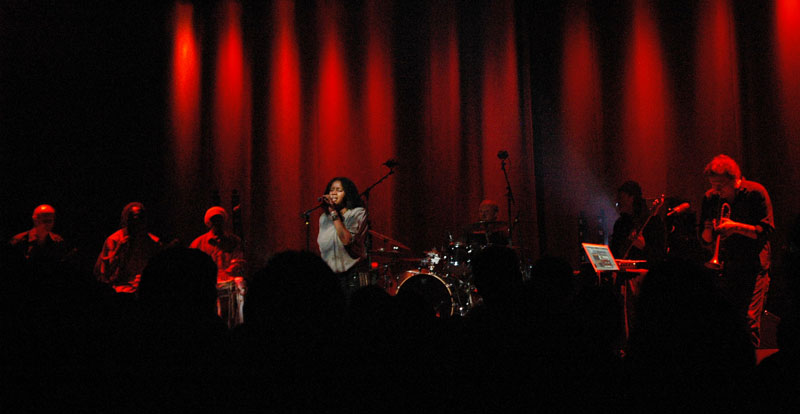 From left: Jon Balke, Aleiu Saine, Baboucar Camara, GIGI Rune Arnesen, Bill Laswell, Nils Petter Molvær
From left: Jon Balke, Aleiu Saine, Baboucar Camara, GIGI Rune Arnesen, Bill Laswell, Nils Petter MolværThere wasn't a weakness to be found amongst the players, though as fine a voice as GIGI possesses, as the band's front-person she could have engaged the audience more, since much of the performance was booty-shaking, hand-clapping music that could have become a tremendous party for the capacity audience in the standing-room Bjørnsunhuset venue. Instead, it was good time rather than great one, though Molvær's performance was absolutely fantastic, as he covered new ground and set another very high bar for the rest of his run as Artist in Residence.
July 19: In the Country
Since releasing its sublimely beautiful debut, This Was the Pace of My Heartbeat (Rune Grammofon, 2005), In the Country has continued to evolve. Rune Grammofon's first piano trio, it has defied all convention as its members—pianist Morten Qvenild, bassist Roger Arntzen and drummer Pål Hausken—have continued to evolve a concept that's often pop-like in structure, but profound in interpretive delivery and a kind of improvisational acumen that's all about the song, rather than the musicians who are playing it.
 Pål Hausken
Pål Hausken What better group, then, to open a series of performances by Rune Grammofon, in celebration of it being Molde Jazz's first Label in Residence? In many ways, In the Country exemplify all that is great about the label: creatively pushing the boundaries of whatever context it finds itself in, and allowing its artists complete and utter freedom to fashion their own sound and approach, and with a commitment that allows them to evolve at their own pace.
In the County doesn't perform that often, and what might be a disadvantage for some clearly becomes an advantage for this group, as its playing retains unequivocal freshness and sense of surprise that could be seen on the faces of its members, as they explored music from all three of their albums, including the sophomore Losing Stones, Collecting Bones (Rune Grammofon, 2007), and their most recent and most ambitious Whiteout (Rune Grammofon, 2009).
Elements of Keith Jarrett—by way of Tord Gustavsen—could be heard in Qvenild's playing, with a very subtle tinge of gospel running through it at times. But he also went to far darker places, as on the opening to Losing Bones's "Can I Come Home Now," its angular melody leading to more dynamic middle section that developed in a different way than the original, which featured at tart guest spot by guitarist Marc Ribot. Arntzen played with spare economy, often repeating phrases with the subtlest variations, as he used harmonics and glissandi in unique ways to both anchor the music and act as a contrapuntal foil for Qvenild. Hausken, more often than not, used large mallets rater than traditional hard-pointed drumsticks, and this—along with towels placed on top of most of his drums—created a denser sound as he built the music, at times, to tumultuous climax, only to drop instantly to a near-whisper.
The group's set ranged from dark and stark to quietly propulsive and thematically compelling; at its most accessible, perhaps, on the soft, brush-driven "Doves Dance," a song that hinted at folk and country but, with its more sophisticated changes and a winding melody which was at the same time oblique yet singable. But its best moments came with the lengthy encore, "Mother," which closed both the evening and Whiteout. The most obvious example of Qvenild's use of electronics to softly morph the sound of his grand piano, he used his laptop to turn his instrument into a thing of shimmering beauty, as he sang the songs lyrics with a kind of understated vulnerability.
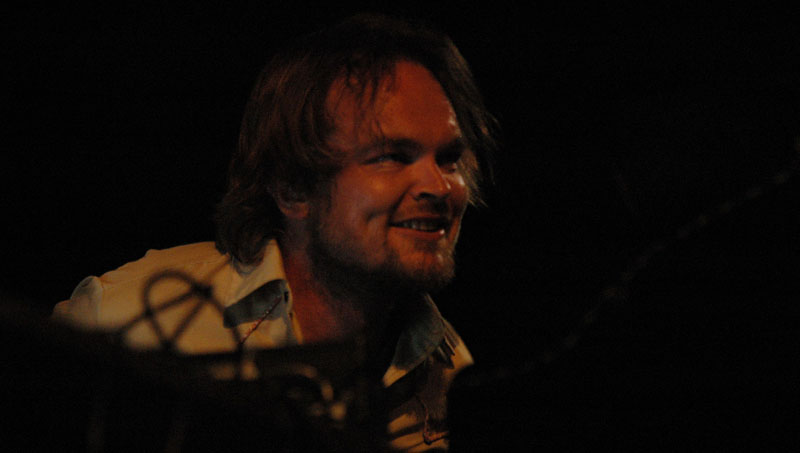 Morten Qvenild
Morten QvenildA group that's getting better with each passing year, its Molde Jazz 2010 performance was a significant improvement over its show at Mai Jazz 2008. Not that there was anything wrong with its show in Stavanger, but while the venue—a 1,000 year-old monastery—was profound if for no other reason than its age, its all-stone construction meant too many reflective surfaces and, consequently, a less-than-ideal sound. Here in Molde, the sound at Kulturhuset was fabulous, and gave the group a head start at the kind of interaction and soft nuance on which its sound has been built.
July 19: Farmers Market
It's hard to imagine dancing in 9/8, much less clapping along, but that's exactly what Farmers Market leader/multi-instrumentalist Stian Carstesen did-or, at least, tried to do—at one point during the first of two late night sets at the Alexandra Park. Situated across from the Quality Hotel Alexandra, it's an all-day party atmosphere, with the beer taps flowing, sausages grilling and crowds of people coming and going from morning 'til night.
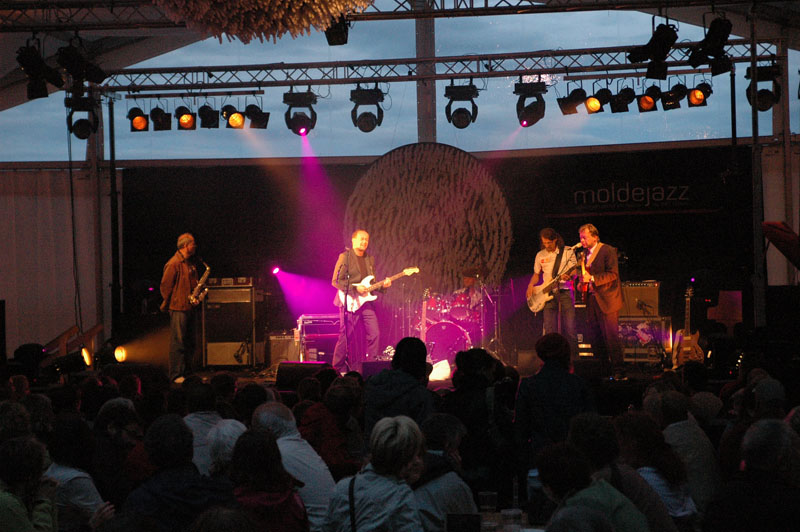 From left: Trifon Trifonov, Stian Carstensen, Jarle Vespestad Finn Guttormsen, Nils Olav Johansen
From left: Trifon Trifonov, Stian Carstensen, Jarle Vespestad Finn Guttormsen, Nils Olav JohansenAlong with Carstensen, Farmers Market features guitarist/vocalist Nils Olav Johansen—heard recently in Bergen with Element: Special Edition, bassist Finn Guttormsen, Bulgarian saxophonist Trifon Trifonov and drummer Jarle Vespestad—last heard in a far more serious environs with pianist Tord Gustavsen at the 2010 TD Ottawa International Jazz Festival. That the group managed to wind its way through a largely continuous set that—with Carstensen switching between electric guitar, pedal steel and accordion—traversed more music per second than John Zorn in his cartoon heyday. Polka, Michael Jackson, Stevie Wonder, film themes (and, at one point, the iconic 20th Century Fox theme), folk, rock and more were twisted, turned, subverted and perverted to Carstensen's agenda, which was about humor, engagement and complete and utter fun.
That the group's four albums—starting with Speed Balkan Boogie (Kirkelig, 1995) and through three more albums up to the most recent Surfin' USSR (Ipecac, 2008)—are fantastic trips through serious playing of music most absurd, but can't capture the full spirit of Farmers Market live. Fortunately there will be a second chance to catch the group on the following day, as Carstensen and the group will, no doubt, deliver more madness and mayhem, in the most fun way possible, taking Molde Jazz 2010 into the wee hours of the morning.
July 20: Javid Afsari Rad
It's a long walk from Molde's main street to the Romsdal Museum, but at Molde Jazz, it's invariably worth it. And sometimes a venue can be almost as special as the concert that takes place within. Iranian expat Javid Afsari Rad's noon hour performance on July 20, at the Romsdal Museum Chapel, was one of those unexpected opportunities to be a part of something that may have seemed relatively small at the time, but which seemed to grow in significance with every thought after the show was over, and throughout the rest of the day.
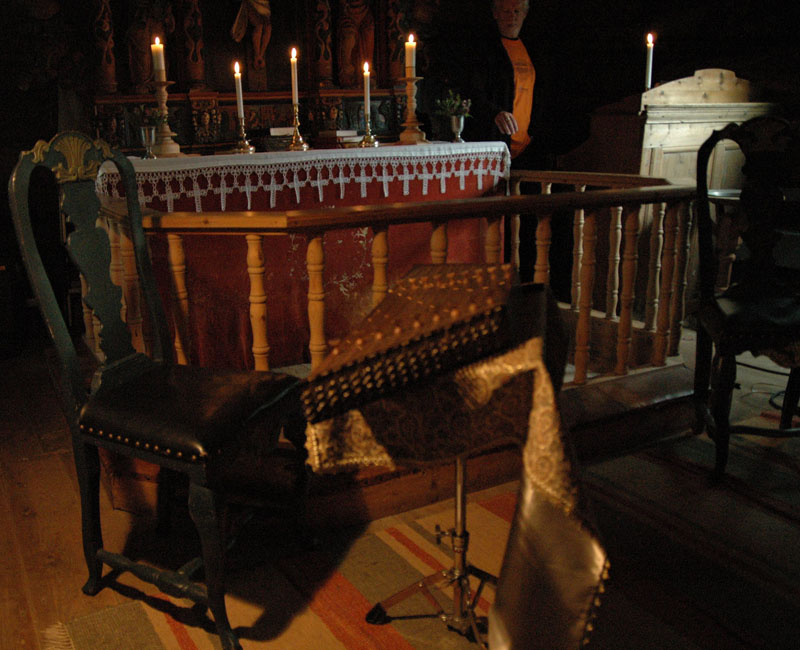 Romsdalsmuseet Kapellet (Romsdal Museum Chapel)
Romsdalsmuseet Kapellet (Romsdal Museum Chapel)The chapel is an old wooden structure with a door so low that even short people had to duck to enter, and with just the barest hint of electricity in the single small light that shone on Rad, who played the santur, a hammered dulcimer with eighteen sets of four strings. Accompanied by percussionist Kaveh Mahmoudyan, Rad sat on a plain chair in front of the pulpit of the chapel, with no PA. Other than that single light, the only other source of illumination was the lit candles spread around the small room, with five rows of divided pews and two more sets of benches at the back. Accommodating, at best, approximately 75 people, the room was full, as Rad and Mahmoudyan played material largely culled from the santurist's latest CD, Afarinesh (Jazzland, 2010), a solo album that, in some ways, compares to Laraaji's classic Days of Radiance (EG, 1980), but with a more middle eastern tonality and little of the overt sound processing that was fundamental to Laraaji's entry in ambient forefather Brian Eno's Ambient Music series.
Using two 72-stringed santurs—one tuned traditionally to a major key, but with the second and sixth tuned a quarter tone lower than the tempered scale; the other tuned to a minor key—Rad combined virtuosity with shimmering, spacious lyricism. With Mahmoudyan's effortless support—all the more compelling for its surprising dynamic breadth within a relatively quiet range where his fingers were sometimes just rubbing his drum's skin, other times his nails merely scratching it—Rad's hauntingly transcendent music roamed from the minimalism-centric "Axis of Love" to "Flames," a minor-keyed tune that, in its deceptive simplicity, referenced some of classical maverick Erik Satie's more melancholic music.
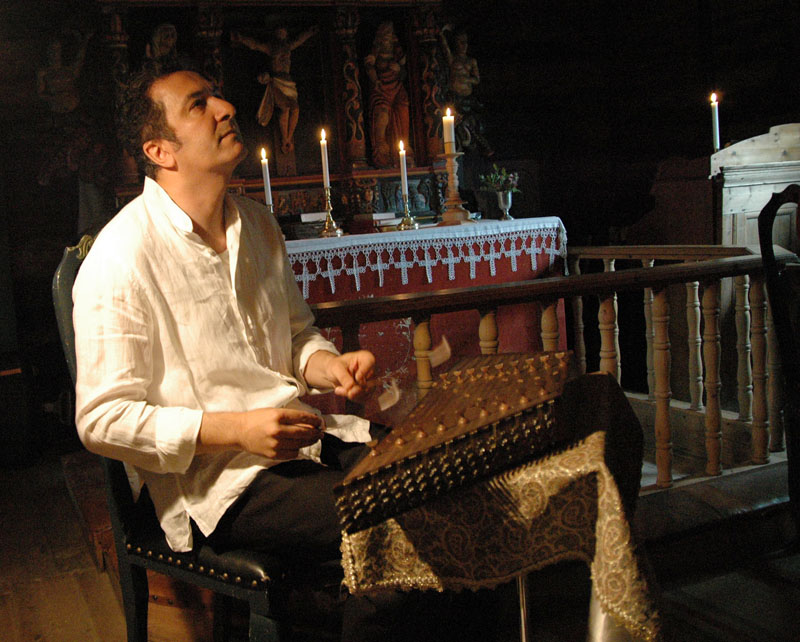 Javid Afsari Rad
Javid Afsari RadRad is involved in many projects, and after the performance discussed some of them outside the chapel, where a day of almost constant rain threatened to spoil (but never succeeded) the second day of Molde Jazz, and certainly impacted attendance at saxophone giant Sonny Rollins' performance later in the day. Rad spoke, with enthusiasm, about more ambitious endeavors ranging from percussion groups like the Zarbang Ensemble to commissioned works for the Norwegian Broadcasting Orchestra., "But sometimes solo is good," he said humbly. Sometimes duo is good, too, and while Rad took plenty of solo space—and gave Mahmoudyan an opportunity or two as well—it was the interplay between the two that created some of the performance's most mesmerizing moments. Rad's show will no doubt go down as one of the festival's sleeper hits; a small, unassuming but thoroughly memorable gem of a show that will keep those lucky enough to be in attendance talking about it long after Molde Jazz 2010 is over.
July 20: Magic Pocket & Trondheim Jazz Orchestra
While Intro Jazz: Årets Unge Jazzmusikere 2010, which began two weeks previous at the 2010 Kongsberg Jazz Festival, wraps up at Molde with a winning group that will win several hundred thousand Norwegian Kroners towards furthering its career, a separate competition at Molde Jazz selected Magic Pocket as its winner in 2009. One of the stipulations of the win was a performance at the festival the following year, and so the group collaborated with the renowned Trondheim Jazz Orchestra for a commissioned show that demonstrated just how successful support for arts education is in Norway.
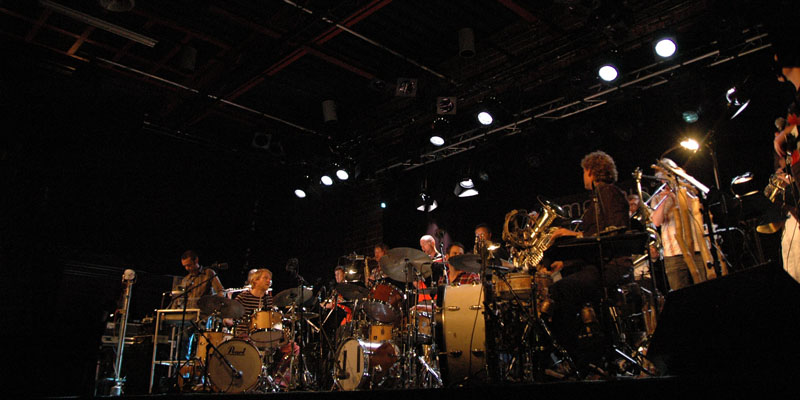 Magic Pocket & The Trondheim Jazz Orchestra
Magic Pocket & The Trondheim Jazz OrchestraWhile Magic Pocket is relatively new, many of its members already have busy careers. Trombonist Erik Johannesen is the most senior member of the group; a member of fellow trombonist Helge Sunde's Ensemble Denada, whose 2009 date at Enjoy Jazz in Mannheim was an early favorite. He's also a busy member of Jaga Jazzist, whose One-Armed Bandit (Ninja Tune, 2010) is already a near-certain pick for one of the year's best, and whose show, a couple weeks back, at the 2010 Kongsberg Jazz Festival will go down as one of its most exhilarating. Tubaist Daniel Herskedal has just released his first album as a leader, City Stories, while trumpeter Hayden Powell, in addition to his own quartet, is a member of hip-hop group Brother K, as well as the Trondheim Jazz Orchestra that was recruited to augment Magic Pocket for its Molde performance. Drummer Erik Nylander is a busy sideman with violinist Ola Kvernberg, whose Folk (Jazzland, 2009) was an unexpected—and most pleasant—surprise, as well as working in Tore Brunborg's saxophone trio with bassist Ole Morten Vågan, last heard on Lucid Grey (DRAVLE, 2009).
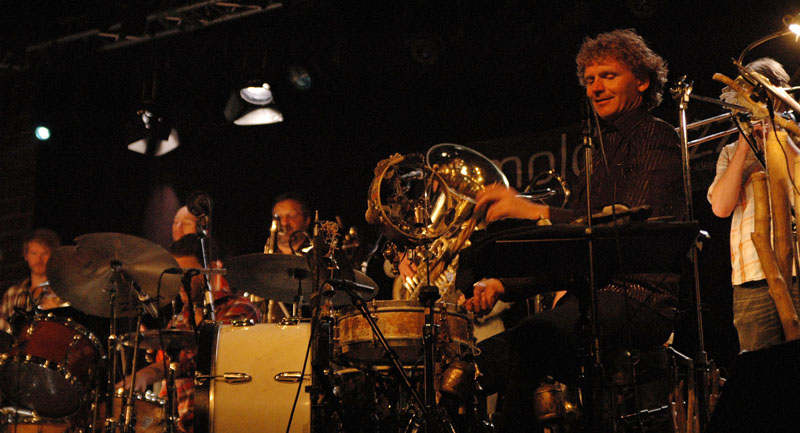 Percussionist Terje Isungset with Magic Pocket & The Trondheim Jazz Orchestra
Percussionist Terje Isungset with Magic Pocket & The Trondheim Jazz Orchestra Trondheim Jazz Orchestra consists of a revolving door of musicians, most of whom have studied at the famed conservatory where significant artists including Arve Henriksen and Hakon Kornstad studied. For Magic Pocket's performance, ten more musicians were recruited, including Ensemble Denada saxophonist Nils Jansen, who brought out his bass saxophone in addition to the more manageably-sized alto. A younger member of the Orchestra, but one whose career is on the ascendancy with the duo Albatrosh and its debut, Seagull Island (Inner Ear, 2009), was tenor saxophonist André Roligheten, while Swedish drummer Jon Fält and Norwegian percussionist Terje Isungset fleshed out a group that could have been top-heavy on the rhythm side but, with Isungset often creating unique textures with his oddly configured kit and collection of stones, was as light as the music required, and as propulsive as the charts demanded.
There was also representation from post-bop group Zanussi Five in the form of saxophonist Eirik Hegdal, who made Z5's performance at Kongsberg's Silver City Sounds junket all the more successful. Fleshed out by younger artists including the especially notable Hanne Rekdal, whose diminutive stature was made all the more so by her choice of instruments (bass flute, bassoon), which were almost as tall as she was. And no Norwegian large ensemble would be complete without some electronics representation, with Anita Kaasbøll's voice augmented with live electronics, and Atle Selnes Nielsen's onstage mad scientist's rig only augmented further by an odd sculpture in the middle of the hall at Kulturhuset that, partway through the performance, came to life and began to project sounds from speakers located at its base.
 With the resurgence of large ensembles in North America, it's important to note that they never actually went away—not, at least, in Norway, where its brass band tradition has created a popular appreciation for bigger configurations, despite the same logistical challenges of touring them. Coupled with the creativity stemming from a commitment to not just instrumental excellence, but musical innovation, it's no surprise that Magic Pocket did, indeed, use Trondheim Jazz Orchestra as an orchestra, and not any kind of conventional big band. The music ranged from amorphous color to fervent pulse, with the bevy of horns played by everyone—including, at times, two tubas and a strange instrument that looked like a trombone on top, but had a large series of valves running perpendicular to it. Shades of contemporary classical music, Norwegian tradition and hints of swing were perpetuated throughout the show, which received enthusiastic applause and hollers of approval from an audience that may have been stacked with families and friends to be sure, but was populated by regular attendees as well. Everyone gave the group not just a seemingly endless round of applause at the end, but a standing ovation as well—a rarity in Norway, as opposed to North America, where it's become de rigueur.
With the resurgence of large ensembles in North America, it's important to note that they never actually went away—not, at least, in Norway, where its brass band tradition has created a popular appreciation for bigger configurations, despite the same logistical challenges of touring them. Coupled with the creativity stemming from a commitment to not just instrumental excellence, but musical innovation, it's no surprise that Magic Pocket did, indeed, use Trondheim Jazz Orchestra as an orchestra, and not any kind of conventional big band. The music ranged from amorphous color to fervent pulse, with the bevy of horns played by everyone—including, at times, two tubas and a strange instrument that looked like a trombone on top, but had a large series of valves running perpendicular to it. Shades of contemporary classical music, Norwegian tradition and hints of swing were perpetuated throughout the show, which received enthusiastic applause and hollers of approval from an audience that may have been stacked with families and friends to be sure, but was populated by regular attendees as well. Everyone gave the group not just a seemingly endless round of applause at the end, but a standing ovation as well—a rarity in Norway, as opposed to North America, where it's become de rigueur.The show was being recorded by engineer Jan Erik Kongshaug of Rainbow Studio in Oslo, and there will be a release of the project within a few months on Trondheim Jazz Orchestra's own imprint, MNJ Records. With writing this good, and a performance that combined the serious with the absurd—most notably in the shape of drummer Fält, who seems to bring a mischievous energy to every project he touches—the recording cannot be released soon enough.
July 20: Burton/Andersen/Smith/Riel
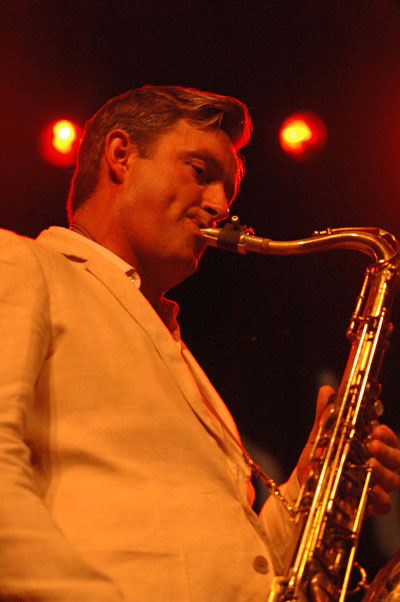 Amongst the characteristics that differentiate so many of the Norwegian festivals is the creation of unique, one-time groupings. In Kongsberg, a couple weeks back, it was the collaboration of poet Jan Erik Vold with guitarist Bill Frisell and bassist Arild Andersen. The Norwegian bassist was back at Molde on its second day, but this time in a more straight-ahead group with vibraphone master Gary Burton, Scottish saxophonist Tommy Smith, and Danish drummer Alex Riel. The four have met and played in various permutations and combinations before but, as Burton explained at the start of the show, never together in one group. Trading music in the time leading up to the show, but with only one rehearsal under its belt, the arrangements were generally simple, but the playing stellar.
Amongst the characteristics that differentiate so many of the Norwegian festivals is the creation of unique, one-time groupings. In Kongsberg, a couple weeks back, it was the collaboration of poet Jan Erik Vold with guitarist Bill Frisell and bassist Arild Andersen. The Norwegian bassist was back at Molde on its second day, but this time in a more straight-ahead group with vibraphone master Gary Burton, Scottish saxophonist Tommy Smith, and Danish drummer Alex Riel. The four have met and played in various permutations and combinations before but, as Burton explained at the start of the show, never together in one group. Trading music in the time leading up to the show, but with only one rehearsal under its belt, the arrangements were generally simple, but the playing stellar.And it was a blowing session from start to finish, as the group wound its way through a number of standards, ranging from pianist Oscar Peterson's "Wheat Land," an easygoing but nevertheless energetic opener that set the bar for the rest of the performance, to the set-closer, Carla Bley's fiery "Syndrome," a tune that Burton has covered repeatedly (along with other Bley compositions), as recently as on Quartet Live (Concord, 2009), his most recent reunion with guitarist Pat Metheny. Smith and Andersen contributed the most unusual material to the set: Andersen a lovely version of the Brazilian-influenced "Backé," first heard on If You Look Far Enough (ECM, 1992); Smith, an adaptation of a Yemenite traditional song that translates as "Tomorrow, Tomorrow." Smith—who brought levity to the set with his introductions-including a quick lesson in dialectic pronunciation of the phrase "how now, brown cow" that had the audience in stitches—also contributed an arrangement of a traditional Irish tune that began with Andersen creating sweeping loops of arco bass.
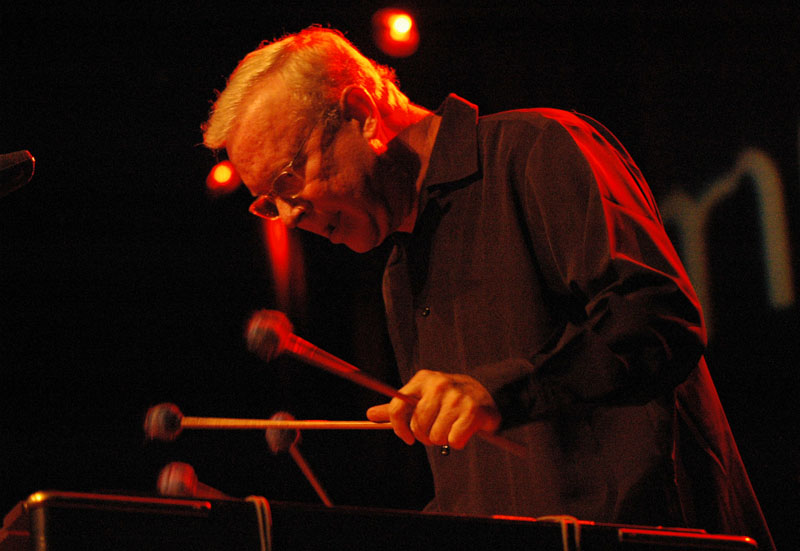 Gary Burton
Gary BurtonAndersen's sound has always been big, but at this particular performance it was huge, and he demonstrated no shortage of virtuosity on his own "Commander Schmuck's Earflap Hat," first heard on his classic A Molde Concert (ECM, 1982), with Frisell, pianist John Taylor and drummer Alphonse Mouzon. Smith—who has become the figurehead for jazz advocacy in Scotland with his Scottish National Jazz Orchestra, describing its players, in conversation after the performance, as more than just kids in a big band, but sophisticated soloists in their own right—has come a long way since his Berklee days in Boston during the mid-1980s, where he first emerged as a kind of stylistic blend of Jan Garbarek and Michael Brecker. Those influences remain, of course, but proved more completely subsumed in a style that favored substance over style; where when he did take off with more rapid-fire lines rather than thoughtful melodism, it felt absolutely in context rather than being an unnecessary display of Smith's undeniable technical acumen.
Riel, a legendary drummer who worked with Dexter Gordon when the saxophonist relocated to Copenhagen in the 1960s, was the perfect confluence of power and delicacy; his light cymbal work and gentle brushes especially noteworthy on Keith Jarrett's balladic "Coral," another Burton choice that the vibraphonist has covered many times over the years. The entire group delivered in a set that was enthusiastically received by the capacity crowd at Bjørnsenhuset, but the most immediate chemistry was between Andersen and Smith, who have been working in a trio with drummer Paolo Vinaccia for the past several years, most recently heard on the outstanding ECM disc, Live at Belleville (2008) but in desperate need of a follow-up.
 From left: Tommy Smith, Alex Riel, Gary Burton, Arild Andersen
From left: Tommy Smith, Alex Riel, Gary Burton, Arild AndersenBurton delivered solo-after-solo of characteristic perfection, with the kind of stunning four-mallet work that continues to inspire younger vibraphonists, and a harmonic voice that has, over the years, honed to absolute distinction and instantaneous recognition. It was a set that may not have rattled any cages in terms of innovation or forward-thinking music, but with four players this strong—whose shared history and relaxed friendship was in evidence throughout the set and afterwards in the dressing room—the playing was absolutely more than enough.
Coming Up: Molde Part 2, including a new project from Ketil Bjornstad, Nils Petter Molvaer Trio, Ola Kvernberg's Liarbird, featuring Joshua Redman, and a late night show from Puma.
Visit Nils Petter Molvær, In the Country, Farmers Market, Javid Afsari Rad, Magic Pocket, Trondheim Jazz Orchestra, Gary Burton, Arild Andersen, Tommy Smith, Alex Riel and Molde Jazz on the web.
Photo Credits
All Photos: John Kelman
Part 1 | Part 2 | Part 3 | Part 4 | Part 5 | Part 6 | Part 7
Tags
Molde JazMolde Jazz Festival
Live Reviews
John Kelman
Nils Petter Molvær
In the Country
Bushman's Revenge
Terje Rypdal
Motorpsycho
Ketil Bjørnstad
Gary Burton
Tommy Smith
Arild Andersen
Alex Riel
Jon Balke
Bill Laswell
john zorn
Painkiller
Eivind Aarset
Jan Bang
Hakon Kornstad
Keith Jarrett
Tord Gustavsen
Marc Ribot
Sonny Rollins
Helge Sunde
Jaga Jazzist
Ola Kvernberg
Tore Brunborg
Terje Isungset
Bill Frisell
oscar peterson
carla bley
pat metheny
John Taylor
Alphonse Mouzon
Jan Garbarek
Michael Brecker
Dexter Gordon
Joshua Redman
PREVIOUS / NEXT
Support All About Jazz
 All About Jazz has been a pillar of jazz since 1995, championing it as an art form and, more importantly, supporting the musicians who make it. Our enduring commitment has made "AAJ" one of the most culturally important websites of its kind, read by hundreds of thousands of fans, musicians and industry figures every month.
All About Jazz has been a pillar of jazz since 1995, championing it as an art form and, more importantly, supporting the musicians who make it. Our enduring commitment has made "AAJ" one of the most culturally important websites of its kind, read by hundreds of thousands of fans, musicians and industry figures every month.


